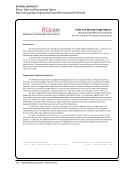SPEC Kit 329: Managing Born-Digital Special Collections and Archival Materials · 35
10. Which of the following strategies does your library employ when ingesting born-digital records
stored on legacy media? Check all that apply. N=60
Current Strategy Planned Strategy N
Storing legacy media as is (without transfer to new media or
server storage and/or keeping it with analog collection)
47 1 48
Developing a collection of legacy hardware that can be used to
retrieve data from legacy media (e.g., 5.25” floppy drives, zip
drives, etc.)
27 10 37
Outsourcing the process of retrieving the data from legacy
media
15 20 35
Building new systems that replicate the function of the legacy
systems (e.g., emulation, virtual systems)
8 9 17
Participating in a collaborative that is developing a collection of
legacy hardware
3 8 11
Other strategy 13 9 22
Number of Responses 57 32 60
If you selected “Other strategy” above, please briefly describe the other strategy(ies) your library
employs or plans to employ when ingesting born-digital records stored on legacy media. N=19
Current Strategy
A documented risk in our holdings is the presence of legacy media scattered throughout the textual holdings. We need
a systematic means of accessing the data in these media to determine if the contents should be preserved as records in
our holdings.
As new collections come in with digital content, we copy them to a server. Have not systematically gone back to find
digital content in legacy collections, so those are being stored on legacy media.
Converting legacy files to modern file types.
For the most part, we are committed to access and will migrate files to the latest usable format to provide access to
the content. We realize that we sacrifice the original look and feel of the files, as well as their functionality, but it is an
acceptable loss given our main users for this content and the nature of our content so far (mostly word processing files).
For example, when we have encountered legacy files on floppy disks, we have converted the files to the PDF-A format
and made them accessible online. For materials with copyright or privacy concerns, these are available in a Virtual
Reading Room, so just like our physical reading room in Special Collections, researchers must fill out an application form
and agree to our terms before entering the Virtual Reading Room online to access the content.
One strategy: Using earlier (Mac) models to open older files, movies, etc. Holding some old software OS9, earlier
versions of iMovie.
Remove data from media ourselves when we are able.
Storage on servers in a “Dark Archives.”
10. Which of the following strategies does your library employ when ingesting born-digital records
stored on legacy media? Check all that apply. N=60
Current Strategy Planned Strategy N
Storing legacy media as is (without transfer to new media or
server storage and/or keeping it with analog collection)
47 1 48
Developing a collection of legacy hardware that can be used to
retrieve data from legacy media (e.g., 5.25” floppy drives, zip
drives, etc.)
27 10 37
Outsourcing the process of retrieving the data from legacy
media
15 20 35
Building new systems that replicate the function of the legacy
systems (e.g., emulation, virtual systems)
8 9 17
Participating in a collaborative that is developing a collection of
legacy hardware
3 8 11
Other strategy 13 9 22
Number of Responses 57 32 60
If you selected “Other strategy” above, please briefly describe the other strategy(ies) your library
employs or plans to employ when ingesting born-digital records stored on legacy media. N=19
Current Strategy
A documented risk in our holdings is the presence of legacy media scattered throughout the textual holdings. We need
a systematic means of accessing the data in these media to determine if the contents should be preserved as records in
our holdings.
As new collections come in with digital content, we copy them to a server. Have not systematically gone back to find
digital content in legacy collections, so those are being stored on legacy media.
Converting legacy files to modern file types.
For the most part, we are committed to access and will migrate files to the latest usable format to provide access to
the content. We realize that we sacrifice the original look and feel of the files, as well as their functionality, but it is an
acceptable loss given our main users for this content and the nature of our content so far (mostly word processing files).
For example, when we have encountered legacy files on floppy disks, we have converted the files to the PDF-A format
and made them accessible online. For materials with copyright or privacy concerns, these are available in a Virtual
Reading Room, so just like our physical reading room in Special Collections, researchers must fill out an application form
and agree to our terms before entering the Virtual Reading Room online to access the content.
One strategy: Using earlier (Mac) models to open older files, movies, etc. Holding some old software OS9, earlier
versions of iMovie.
Remove data from media ourselves when we are able.
Storage on servers in a “Dark Archives.”










































































































































































































